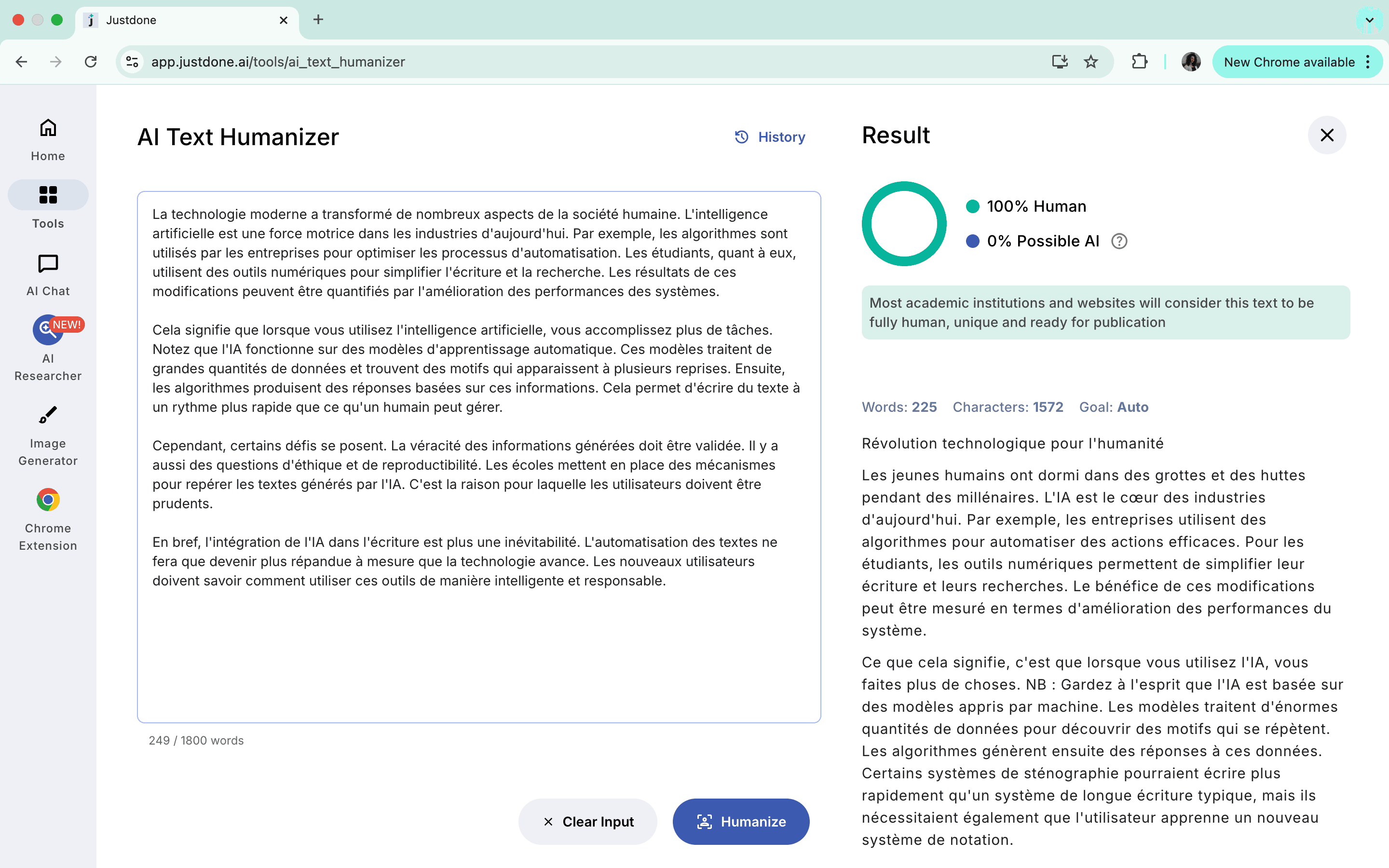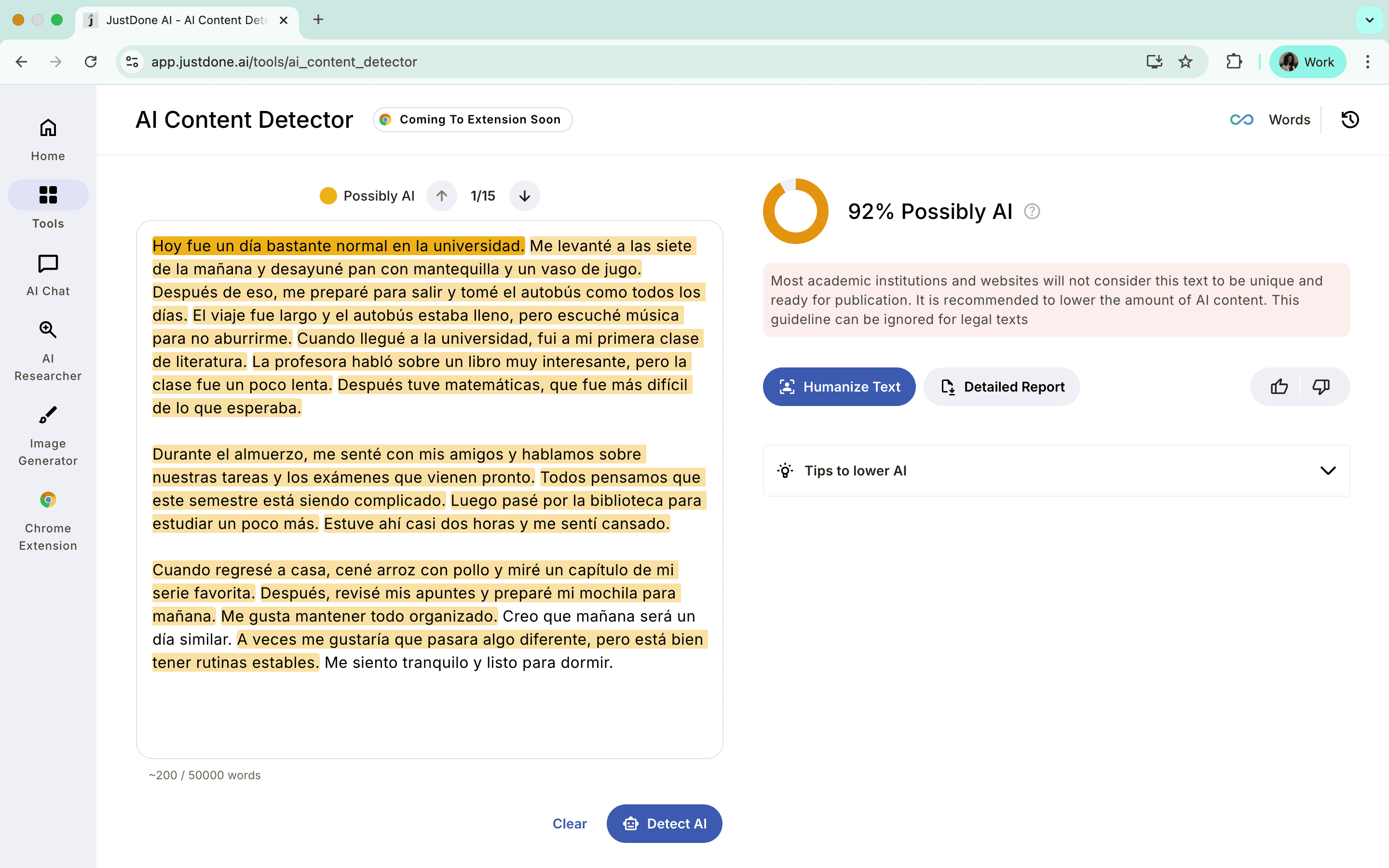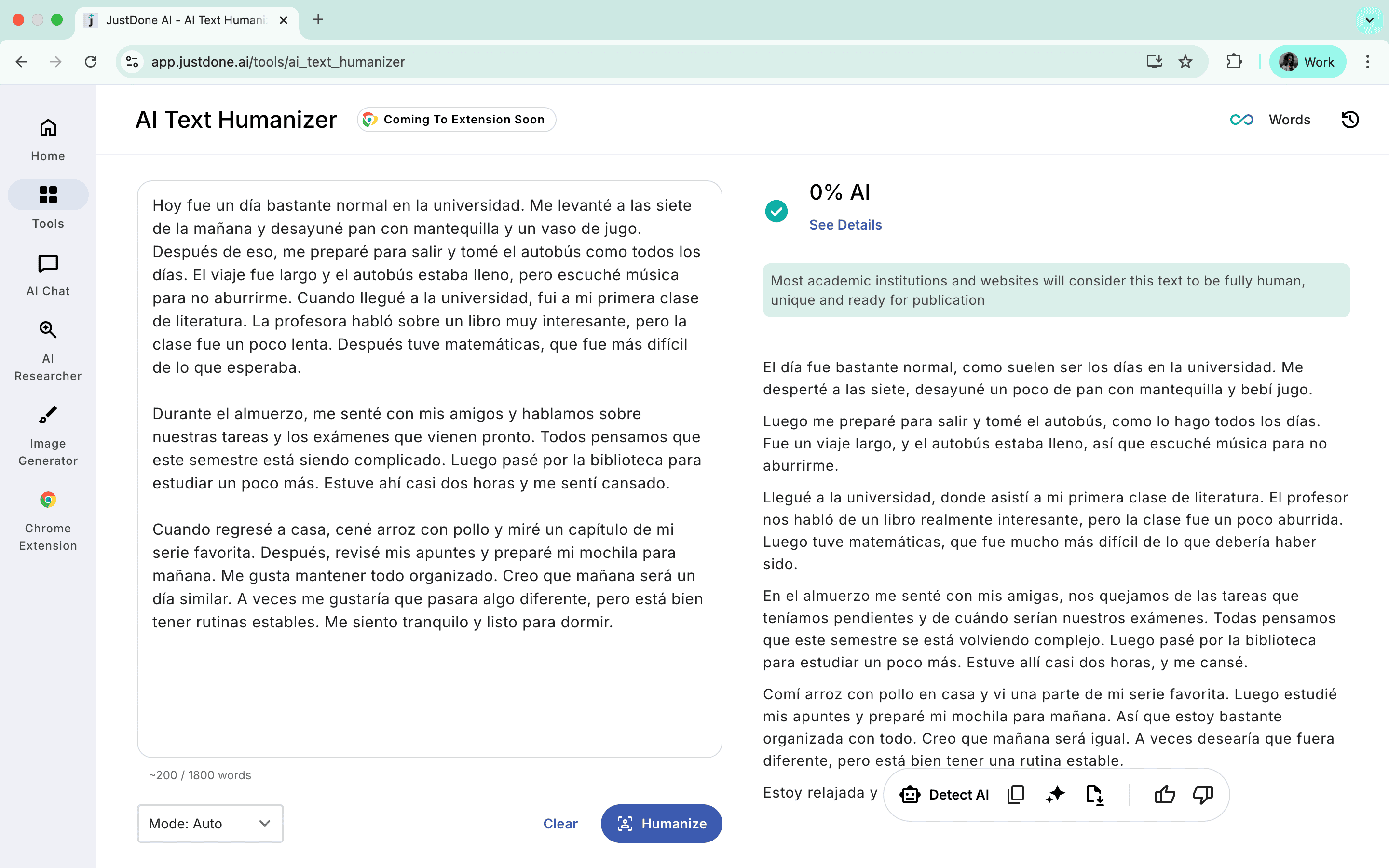If you're not a native English speaker or need to humanize your writing in other languages, look at a multilingual AI humanizer.
When I first started using AI tools, my focus was mainly on English. As I helped learners from Spain, Brazil, Germany, and France, I realized that humanizing non-English AI content brings new challenges. It’s not just about fixing grammar. You need to rewrite text so it sounds like something a real person would say. That’s much harder when switching between different languages and cultures.
Let’s break down what I’ve learned about AI humanizer languages and why tools like JustDone make a real difference in writing across cultures.
AI Humanizer Accuracy Across Languages
Many of the AI tools are built mainly for English. That means most AI humanizers work best when dealing with English texts. The databases and training models are optimized for English grammar, sentence flow, and tone. But when you switch to Spanish, French, or German, the result becomes less smooth.
I’ve seen this firsthand. A student from Paris once used an English-optimized humanizer to rewrite her French essay. The output sounded correct on paper, but it read like something from a formal manual rather than a real student. The humanizer missed everyday phrases and conversational structures. Words like “en fait” or "bref", which are commonly used in natural French writing, were completely absent.
The same thing happens in other languages. Spanish writing often includes personal expressions or culturally specific transitions. German tends to use longer, compound sentences. A good multilingual AI humanizer should be able to adjust for these patterns. Unfortunately, most don’t.
Another challenge is AI detection. Tools that flag AI-generated text are usually trained on English samples, which means they sometimes miss AI-written content in other languages or mistakenly flag human text as artificial. This makes it harder for students to balance between rewriting AI-generated content and staying under the radar.
That’s one of the reasons I recommend JustDone humanizer to my students. It doesn’t just translate. It makes text really human.
 When you use the JustDone multilingual AI humanizer, it respects cultural tone and adjusts the structure of your text to sound like a real person wrote it. I tested it with Spanish essays and found that it kept casual phrases intact while still improving the grammar. The initial piece was flagged as 92% AI-generated.
When you use the JustDone multilingual AI humanizer, it respects cultural tone and adjusts the structure of your text to sound like a real person wrote it. I tested it with Spanish essays and found that it kept casual phrases intact while still improving the grammar. The initial piece was flagged as 92% AI-generated.
 After JustDone humanizer, the result is 0%. Take a look at the screen.
After JustDone humanizer, the result is 0%. Take a look at the screen.

That’s exactly the type of humanization that helps you avoid problems with AI detectors and also connect with real readers.
Translate vs Humanize: Cultural Context
A common mistake students make is to generate text in English, translate it, and then run it through a paraphraser or humanizer. But translation and humanization aren’t the same thing.
Translation focuses on word-for-word or sentence-by-sentence conversion. Humanization is about making the text sound natural, with the right tone for the context. If you just translate AI-generated text and then paraphrase it, you’re likely to end up with writing that feels awkward or disconnected from cultural expectations.
I once worked with a Brazilian student writing a scholarship application in Portuguese. She started by drafting it in English using AI, then translated it and used a paraphrasing tool to clean it up. The final version was formal and distant, which isn’t how people in Brazil usually write personal letters. Her original story, full of emotion and personal reflection, got lost in the process.
This problem happens because humanizers often focus on grammar, not culture. But real human communication is about more than grammar. It’s about knowing when to be formal and when to be conversational. For academic writing in German, you need precision and complexity. For a Spanish personal statement, you might need a warmer tone with more casual phrasing.
That’s why JustDone is different. It lets you adjust the tone, not just the grammar. No matter what language and text you need, JustDone makes the language sound right for the situation. It doesn’t just change words; it changes how the text feels.
Top 5 AI Humanizer Tools for Different Languages
After spending a year testing AI humanization tools, I’ve narrowed down the top five for multilingual use. Here’s what I’ve learned from working with students and content creators who write in multiple languages.
| Tool | Best for | Language support | Strengths | Weaknesses |
| JustDone | Academic and creative rewriting | English, Spanish, French, German, Portuguese, Turskish, etc | Natural human tone, tone control | None majot - good all-in-one-tool |
| Quillbot | Quich paraphrasing | Primarilty English, but with support of others (Spanish, French) | Good for short sentences, familiar interface | Sounds stiff in other languages; weaker for long texts |
| Undetectable.AI | Bypassing AI detecors | Mostly English | Makes text pass detection tools | Lack tone adapration; not natural in other languages |
| Smodin | Multilingual rewriting | Several languages | Decent multilanguage coverage | Too mechanical |
| Paraphraser.io | Quick fixes | Multiple languages | Fast and simple | Shallow edits, tone and flow issues |
JustDone AI humanizer is my go-to recommendation. It doesn’t just fix grammar; it helps you rewrite AI-generated text into something that feels human. It works well in English, Spanish, French, German, Portuguese, etc., and you can control the tone based on the type of writing you’re doing. I use it regularly to help students rewrite essays and personal statements while keeping their natural voice.

QuillBot is another popular tool. It offers paraphrasing and some language options, but in my experience, it works best in English. When used in French or Spanish, it often makes the writing sound overly formal or stiff. It’s fine for short sentences, but longer essays tend to lose their flow.
Undetectable.AI is widely used by people trying to beat AI detectors, but it mainly focuses on English. When I tried it with German and Spanish texts, it didn’t adjust for tone or structure well. The output was clean but didn’t sound natural.
Smodin has a humanizer feature with support for several languages, but it tends to be too mechanical. It often replaces words without changing sentence structure, which can make the writing sound odd, especially for personal or creative work.
Paraphraser.io has multilingual paraphrasing capabilities, but it’s designed for quick fixes rather than full essay rewrites. It’s useful for short phrases but not reliable for larger assignments where tone and cultural context are important.
Conclusion: Choosing the Right Multilingual AI Humanizer
Writing with AI isn’t just about avoiding plagiarism or passing AI detection checks. It’s about making sure your content feels real and fits the expectations of the people reading it. Whether you’re writing in English, Spanish, German, or French, you need to go beyond simple grammar corrections. You need to adjust tone, respect cultural norms, and sound like yourself.
That’s why picking the right multilingual AI humanizer matters. From all the tools I’ve tested, JustDone stands out because it helps you humanize content while keeping your personal style intact. It doesn’t just work for English; it’s a true non-English humanizer that lets you write naturally, no matter the language. Whether you’re working on a scholarship essay, a business email, or a blog post, JustDone is the best option for learners who want to sound real while using AI to save time.